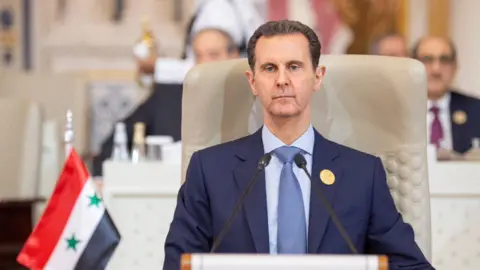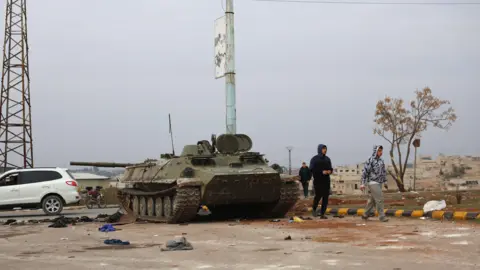Shaken by Assad’s sudden fall, Syria faces seismic turning point
 Getty Images
Getty ImagesIn the end the Assad regime was so hollow, corrupt and decayed that it collapsed in less than a fortnight.
No one I have spoken to has been anything other than astonished by the speed with which the regime turned to dust.
In the spring of 2011, the year of the Arab uprisings, it was different, when Syrians tried to grab some of the revolutionary magic that had swept away the presidents of Tunisia and Egypt and was threatening the veteran strongmen of Libya and Yemen.
By 2011, the regime created by Hafez al-Assad and passed to his son Bashar on his death in 2000 was already corrupt and decadent.
But the system that Hafez built still had much of the brutal, ruthless strength that he believed was necessary to control Syria. Assad senior had seized power in a country that was prone to coups and delivered it to his son and heir without a significant challenge.
Bashar al-Assad went back to his father’s playbook in 2011.
It is hard to imagine now, but back then he had more legitimacy among some of Syria’s population than the old dictators swept away by crowds chanting the slogan of that year – “The people want the fall of the regime”.
Bashar al-Assad was a vocal supporter of the Palestinians and of Hezbollah during its successful fight against Israel in the 2006 Lebanon war. He was younger than the ex and soon to be former Arab leaders.
Since his father’s death he had been promising reform. Some Syrians still wanted to believe him in 2011, hoping demonstrations were the spur he needed for the change that he had promised, until he ordered his men to shoot peaceful demonstrators dead in the streets.
A British ambassador in Syria once told me that the way to understand the Assad regime was to watch Mafia films like The Godfather. The obedient could be rewarded.
Anyone who went against the head of the family or his closest lieutenants would be eliminated. In Syria’s case that could mean the gallows, or a firing squad, or indefinite incarceration in some underground cell.
We’re seeing them now, emaciated and pale, blinking into the light, filmed on the mobiles of the rebel fighters who have freed thousands of them from years behind bars.
 Reuters
ReutersThe weakness of the regime, to the point that it collapsed like a soggy paper bag, was disguised by the fearsome and repressive gulag it still maintained.
The international consensus was that Bashar al-Assad was weak, dependent on Russia and Iran, and presiding over a country he had fractured to preserve his family’s rule – but still strong enough to be regarded as a fact of Middle Eastern life, who could even be useful.
In the last days before rebels burst out of Idlib, it was widely reported that the US, Israel and the United Arab Emirates were trying to detach Assad’s Syria from Iran.
Israel had been launching increasingly heavy airstrikes against targets inside Syria it said were part of the supply chain Iran used to get weapons to Hezbollah in Lebanon.
Israel’s offensive in Lebanon had dealt severe blows to Hezbollah, but the idea was to stop it regenerating. At the same time the UAE and the US were trying to find incentives for him to break the alliance with Tehran, relaxing sanctions and allowing Assad to continue his international rehabilitation.
Both Benjamin Netanyahu and Joe Biden have claimed credit for the fall of the Assad regime. There is something in that.
The damage Israel inflicted on Hezbollah and Iran with US weapons and constant support, and Biden’s supply of arms for Ukraine, made it impossible, even undesirable, for Assad’s closest allies to save him.
But the fact that they saw Assad as part of their strategy to contain and damage Iran until days before his fall indicates clearly that they did not for a moment believe him to be days away from a midnight flit to Russia.
They did contribute to his end, more by accident than design.
 Getty Images
Getty ImagesThe fall of the regime might have ended Iran’s supply chain, if Syria’s new rulers decide their deals with others are more useful than the Iranian alliance.
All sides are thinking hard and thinking again about what comes next, and it is too soon to draw definite conclusions. Syrians, their neighbours, and the wider world are now confronted by another geopolitical earthquake, the biggest of the series that has followed the Hamas attacks on Israel in October last year. It might not be the last.
Iran is seeing the final collapse of the main planks of the network it called the axis of resistance. Its most important components have been transformed; Hezbollah badly damaged and the Assad regime gone.
Iran’s rulers might want to follow up on hints of talks on a deal with Donald Trump once he takes office. Or its new strategic nakedness might push it into a fateful decision to turn its highly enriched uranium into a nuclear weapon.
Syrians have every reason to rejoice. In the years after 2011, for all the repression and brutality of the regime, Assad and his acolytes could still find men who would fight. Many of the troops I met on front lines told me that Assad was a better option than the jihadist extremists of Islamic State group.
In 2024, faced by a well-organised rebel force that insisted it was nationalist, Islamist but no longer jihadist, the army’s reluctant conscripts refused to fight, stripped off their uniforms and went home.
 EPA
EPAThe best scenario is that Syrians, helped by the big players in the region, will find a way to create a postwar mood of national reconciliation, not a wave of looting and revenge that will drag the country into a new war. Abu Mohammad al Joulani, the leader of victorious HTS, has called for his men and all of Syria’s sects to respect each other.
His men have removed the regime, and he is the closest Syria has to a de facto leader.
Syria, though, has dozens of armed groups that do not necessarily agree with him and will want to grab power in their own areas. In southern Syria, tribal militias did not recognise the writ of the Assads. They will not follow orders they don’t like from the new set up in Damascus.
In the eastern desert, the US saw a big enough threat from remnants of the Islamic State group to launch waves of air strikes. The Israelis, alarmed by the prospect of an Islamist state on their border, are pounding the military infrastructure of Syria’s armed forces.
It might be better to find a way to make a reformed Syrian Arab Army part of the solution in a country without much law or order. The reckless decision by the US in 2003 to dissolve the Iraqi armed forces had disastrous consequences.
In Turkey, President Erdogan must be satisfied by what he sees.
Erdogan’s Turkey did more than any other power to preserve the autonomy of Idlib province, where HTS was transforming itself into a fighting force when Syria seemed to be in the deep freeze.
Erdogan might see his influence lapping Israel’s borders, at a time when Israel-Turkey relations have been poisoned by the war in Gaza.
The worst scenario for Syrians is that their country will follow the example of two Arab dictatorships that spun into violent chaos after the fall of their regimes.
Colonel Gaddafi of Libya and Saddam Hussein of Iraq were removed without a ready-made replacement waiting in the wings. Ill-considered foreign intervention did much to create two catastrophes.
The vacuum left by the dictators was filled by waves of looting, revenge, power grabs and civil war.
Syrians have not been in charge of their own destiny for generations. Individuals were robbed of it by the two Assad presidents and their followers. The country lost it after war left it so weakened that bigger foreign powers used it to increase and preserve their own power.
Syrians still do not have agency over their lives. They might have a chance of creating a new and better country if they did.
